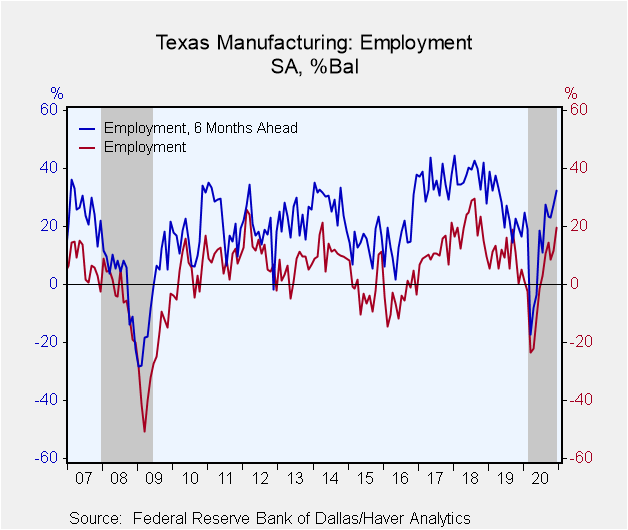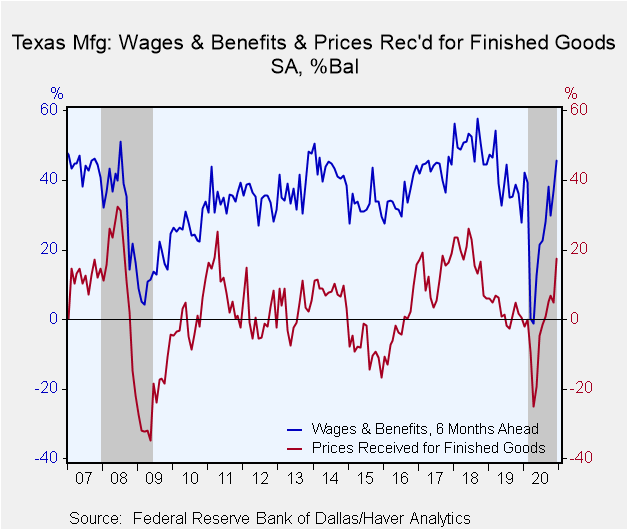 Global| Dec 28 2020
Global| Dec 28 2020Texas Manufacturing Activity Strengthens in December
by:Sandy Batten
|in:Economy in Brief
Summary
• Headline index of general business conditions slipped for second month. • However, subindexes pointed to a meaningful pickup in activity. • Expectations index also eased. The Federal Reserve Bank of Dallas reported that its Texas [...]
• Headline index of general business conditions slipped for second month.
• However, subindexes pointed to a meaningful pickup in activity.
• Expectations index also eased.
The Federal Reserve Bank of Dallas reported that its Texas Manufacturing Outlook Survey General Business Activity Index fell to 9.7 in December from 12.0 in November and 19.8 in October. Despite the decline, the index was positive for the fifth straight month. Data were collected in the period December 14-22, 2020 with 113 Texas manufacturers responding to the survey.
While the headline index pointed to a slowdown in manufacturing activity across Texas, the subindexes pointed to a meaningful pickup. The production measure rebounded sharply to 25.5 in December, tying the highest reading since August 2018, from 7.2 in October. Forty percent of respondents reported an increase in production in December while only 15% reported a decline. The new orders growth measure increased to 16.5, also the highest since August 2018, from 9.7. The shipments measure jumped to 21.9 from 13.7, and unfilled orders rose to 8.7, its highest since August 2018.
The employment reading rose to 19.6 in December, its highest since October 2018, from 11.7. Nearly 30% of respondents reported increased hiring, a recovery high, while only 10% indicated a decline. Wages and benefits also rose–to 19.6 in December from 13.6.
The prices received measure jumped to 17.4 in December, its highest reading since July 2018, from 4.7, a sharp contrast to the deflation reported just six months ago. More than 20% of respondents reported receiving higher prices while just 3.2% indicated a decline. The raw materials price measure surged to 49.0, its highest level since October 2018.
The headline index of expectations for overall business activity ebbed for the second consecutive month. The measure weakened to 17.6 in December from 25.8. However, all of the major subindexes, notably production, posted meaningful gains.
Each index is calculated by subtracting the percentage reporting a decrease from the percentage reporting an increase. When all firms report rising activity, an index will register 100. An index will register -100 when all firms report a decrease. An index will be zero when the number of firms reporting an increase or decrease is equal. Data for the Texas Manufacturing Outlook can be found in Haver's SURVEYS database.
| Texas Manufacturing Outlook Survey (SA, % Balance) | Dec | Nov | Oct | Dec '19 | 2019 | 2018 | 2017 |
|---|---|---|---|---|---|---|---|
| Current General Business Activity Index | 9.7 | 12.0 | 19.8 | -3.9 | -1.1 | 25.8 | 20.6 |
| Production | 25.5 | 7.2 | 25.5 | 3.9 | 8.9 | 21.4 | 20.2 |
| Growth Rate of New Orders | 16.5 | 9.7 | 14.3 | -6.0 | -1.1 | 14.8 | 11.4 |
| Employment | 19.6 | 11.7 | 8.7 | 5.3 | 9.5 | 20.0 | 11.4 |
| Wages & Benefits | 19.1 | 13.6 | 16.5 | 13.3 | 23.5 | 29.7 | 22.2 |
| Prices Received for Finished Goods | 17.4 | 4.7 | 6.8 | 0.4 | 2.5 | 17.6 | 12.7 |
| General Business Activity Index Expected in Six Months | 17.6 | 25.8 | 28.4 | 5.2 | 6.4 | 31.6 | 34.6 |
| Production | 47.3 | 40.8 | 47.2 | 36.4 | 35.6 | 48.6 | 46.9 |
| Growth Rate of New Orders | 33.5 | 31.3 | 37.9 | 26.3 | 25.2 | 35.8 | 37.7 |
| Employment | 32.5 | 27.5 | 23.1 | 16.5 | 26.1 | 37.7 | 35.3 |
| Wages & Benefits | 45.7 | 37.0 | 29.9 | 27.7 | 39.7 | 50.4 | 43.4 |
Sandy Batten
AuthorMore in Author Profile »Sandy Batten has more than 30 years of experience analyzing industrial economies and financial markets and a wide range of experience across the financial services sector, government, and academia. Before joining Haver Analytics, Sandy was a Vice President and Senior Economist at Citibank; Senior Credit Market Analyst at CDC Investment Management, Managing Director at Bear Stearns, and Executive Director at JPMorgan. In 2008, Sandy was named the most accurate US forecaster by the National Association for Business Economics. He is a member of the New York Forecasters Club, NABE, and the American Economic Association. Prior to his time in the financial services sector, Sandy was a Research Officer at the Federal Reserve Bank of St. Louis, Senior Staff Economist on the President’s Council of Economic Advisors, Deputy Assistant Secretary for Economic Policy at the US Treasury, and Economist at the International Monetary Fund. Sandy has taught economics at St. Louis University, Denison University, and Muskingun College. He has published numerous peer-reviewed articles in a wide range of academic publications. He has a B.A. in economics from the University of Richmond and a M.A. and Ph.D. in economics from The Ohio State University.










